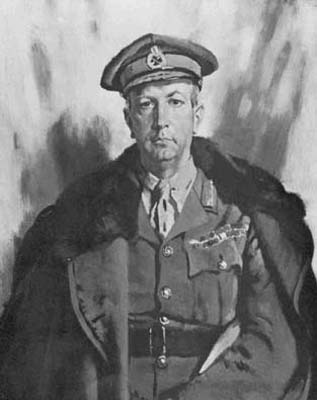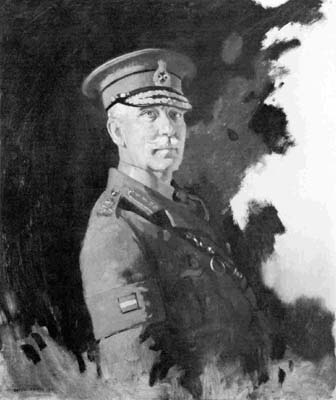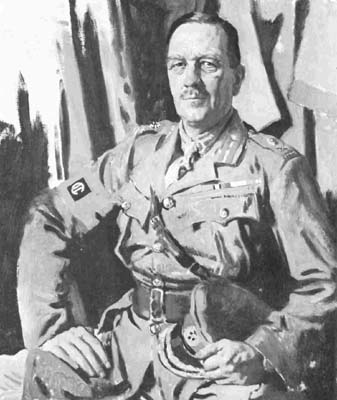
Bulletin 6 (III:2), 1965
Home
Français
Introduction
History
Annual Index
Author &
Subject
Credits
Contact



Orpen
Portraits in the Canadian
War Memorials Collection
by Robert F. Wodehouse,
Curator of War Art
Pages 1 | 2 |
3 | 4
The portrait of Captain Hoidge is also of some
interest. For many years it was listed in the National Gallery
records as A Canadian Airman. However, a few years ago Air Marshal Curtis identified this picture as that
of Captain Hoidge with whom he had flown
in France. (6) Hoidge was one of the outstanding pilots in 1917
in the Royal Flying Corps and Orpen relates in his book how Hoidge
and Rhys Davids, another outstanding pilot, were selected by General
Trenchard, head of the Royal Flying Corps, to be painted. The
portrait illustrated on page 52 of An On!ooker in France was
painted at this time and shows Hoidge as a lieutenant and MC.
He was a personal friend of Orpen.
The painting in the National Gallery shows Hoidge as a
Captain and with the Bar to his MC. He had been in an aircraft
accident in England in December 1917. In the painting he is wearing a head bandage as a result of the accident. The
date of this painting can be tentatively set therefore as early or
mid-1918, before Hoidge returned to flying duties in France in
September.
The seven army portraits were exhibited as a group for the first time in many years during the summer of
1964. They formed part of a special showing of paintings assembled
to commemorate 50 years since the onset of the First Great War. The
portrait of Captain Hoidge is normally hung in the War Collections
as part of the permanent display.
Sir Arthur William Currie (1875-1953) was born in the village of
Napperton, Middlesex County, Ontario, 5 December 1875, the son of William Garner Currie and Jane Patterson. He was educated at the
Strathroy Collegiate Institute. In 1893 he went to British Columbia, and became a school teacher. Eventually he went into business
in Victoria, British Columbia; and there became the senior partner
in one of the leading real estate firms on Vancouver Island. When the Great War broke out in 1914, he
was a lieutenant - colonel in the militia, having risen from the
ranks to command the 5th Canadian Garrison Artillery and then the
50th Gordon Highlanders of Victoria. In September 1914 he was
given command of the 2nd Canadian Infantry Brigade, being promoted
full colonel in February 1915 and brigadier-general 4 March 1915. In
1916 he was placed in command of the 1st Canadian Division, with the rank of major-general; and in 1917 he succeeded Sir Julian Byng
as commander of the Canadian Corps, with the rank of lieutenant-general. This last position he retained, with great credit to
himself and to the Corps, throughout the remainder of the war. After
the Armistice, he commanded the Canadian forces on the Rhine; and
on his return to Canada in 1919 he was appointed inspector-general
of the Canadian Militia. In 1920 he was offered and accepted the
position of principal and vice-chancellor of McGill University,
Montreal; he retained this post until his death in Montreal on 30
November 1933. He was created a CB in 1915, a KCMG in 1917, a KCB in
1918and a GCMG in 1919; and the honorary degree of LLD was conferred
on him by many universities. At the time of his death he was grand
president of the Canadian Legion of the British Empire Service League.
Sir Archibald Cameron Macdonell (1864-1941) was born at Windsor,
Canada West, 6 October 1864, the son of Samuel Smith Macdonell. He graduated from
the Royal Military College, Kingston, in 1886; after serving for two
or three years in the Canadian permanent militia, he transferred to
the Royal North West Mounted Police. He served in the South African War with the Canadian Mounted Rifles, and rose to
the rank of Lieutenant-colonel. He became a superintendent of the Royal
North West Mounted Police in 1903; he was given command of Lord
Strathcona's Horse when the World War of 1914-18 broke out, In 1915
he was given command of the 7th Canadian Infantry Brigade, with the
rank of brigadier-general; in 1917 he was appointed to command the 1st Canadian Division, with the rank of major-general; from 1919 to
1925 he was commandant of the Royal Military College, Kingston. He
was awarded the DSO in 1901, the CMG in 1916, the CB in 1917, and
the KCB in 1919; on retirement he was promoted lieutenant-general.
He died at Kingston, Ontario, on 23 December 1941.
Sir Henry Edward Burstall (1870-1944)
was born at Quebec, 26 August 1870, the son of John B. Burstall and Fanny Bell Forsyth. He was educated at
Bishop's College, Lennoxville, and the Royal Military College,
Kingston. He was commissioned in the Royal Canadian Artillery in
1889; served with the force in the Klondyke from May 1898 to June 1899; and served in South Africa with
1st Canadian Contingent. He served with the South African
Constabulary in the Transvaal from April 1901 to June 1902. He was
mentioned in despatches. Appointed lieutenant-colonel 1908 and
appointed to command Royal Canadian Horse Artillery 1911. Served in
World War 1914-18 as brevet colonel and Brigadier-General Commanding
Artillery, 1st Canadian Division, 1914-15. As a major-general he was General
Officer Commanding Royal Artillery 1915-16, and was General
Officer Commanding 2nd Canadian Division 1916-18. He was created CB
in 1915; CMG in 1917; KCB in 1918;and KCMG in 1919; he also received
some foreign decorations. He was many times mentioned in despatches.
Quartermaster-General at Department of National Defence 1919-20 and
Inspector-General until his release in 1925. He settled in England
and died in 1944 at Headbourne Worthy, Hampshire, England.
Next Page | Louis
James Lipsett
1 | 2 |
3 | 4
Annual Index | Author & Subject | Credits | Contact
This digital collection
was produced under contract to Canada's Digital Collections program,
Industry Canada.
"Digital
Collections Program, Copyright
© National Gallery of
Canada 2001"